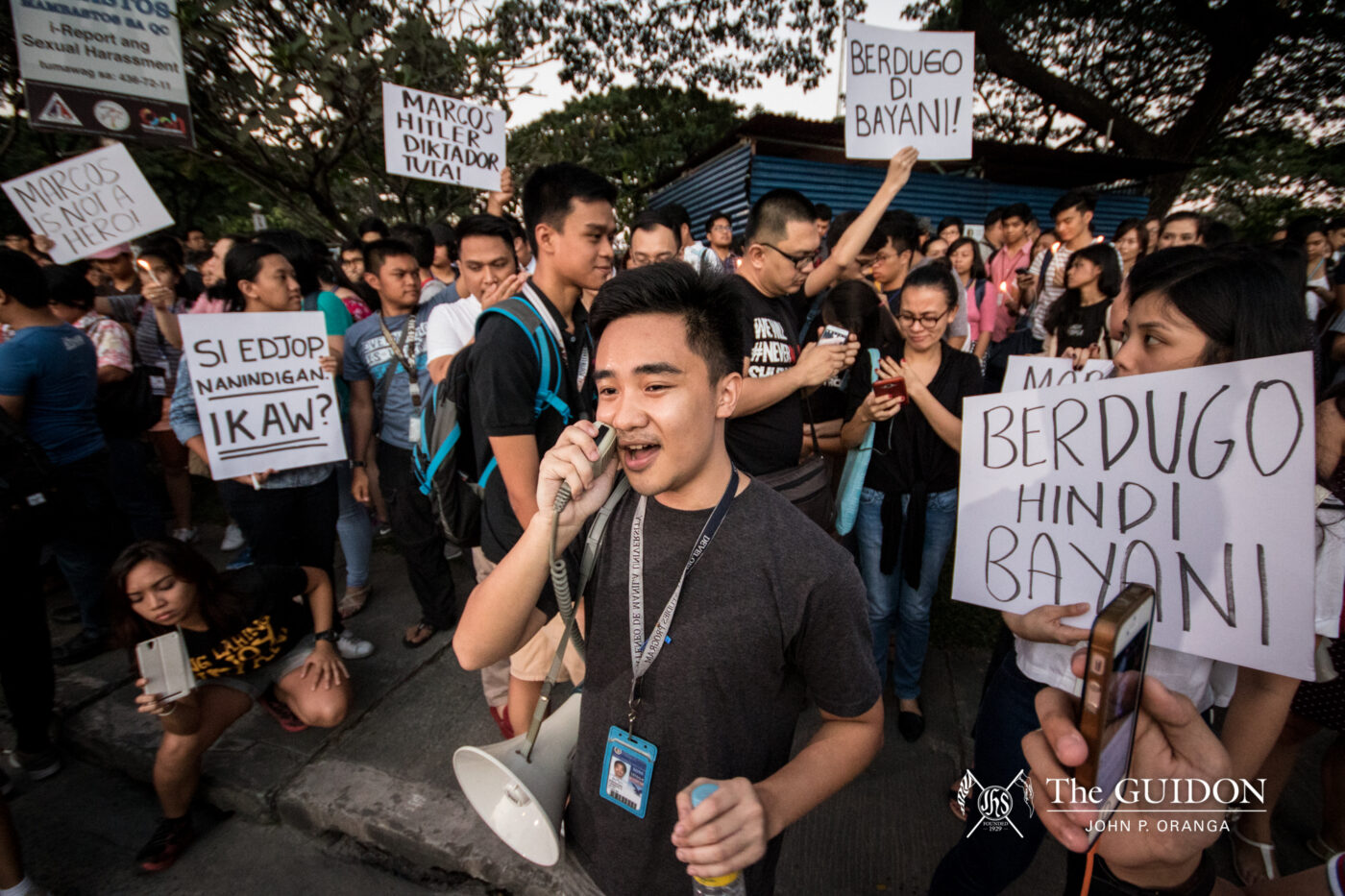“Atenistang kabataan, ngayon ay lumalaban!”
Hundreds of members from the Ateneo community joined a protest along Katipunan Avenue against the decision of the Supreme Court (SC) to allow the burial of the dictator Ferdinand Marcos at the Libingan ng mga Bayani.
The protest was jointly organized by the Sanggunian and the Union of Students for the Advancement of Democracy (USAD) shortly after the court decision was released. Despite the short notice, a large crowd of roughly 400 protesters turned out, including alumni and some non-Atenean civilians.
Protesters repeatedly chanted slogans such as “Hindi bayani si Marcos!” and even the Martial Law-era chant “Marcos, Hitler, diktador, tuta!” in chorus and urged passing motorists to honk their horns in the name of justice. Candles also lined up the sidewalk along Katipunan.
The demonstration turned into a full-blown noise barrage when some members of the Ateneo Blue Babble Batallion joined the protest and whipped up their drums. Noisemakers and sirens from megaphones kept the two-hour protest alive.
Fragments of the dark past
In a 9-5 vote, the high court upheld President Rodrigo Duterte’s decision ordering Marcos’ burial at the Libingan in fulfillment of his campaign promise. The president said that burying Marcos’ remains with the other former presidents at the same resting place would expedite the “healing” process of the nation.
In a report by CNN Philippines, the SC cited the following reasons for allowing the burial: first, there was no law prohibiting the hero’s burial, and thus, the president did not commit a grave abuse of discretion; second, the president has the power to reserve for specific purposes any lands under public domain; third, Marcos can be buried at the Libingan under AFP regulations; fourth, that Marcos was not dishonorably discharged; and fifth, that Marcos was not convicted of crimes of moral turpitude.
Student organizers invited a handful of Martial Law victims who spoke about the horrors they went through and the disappointment they felt upon hearing the ruling.
The speakers turned emotional as they recounted their experiences both during the dictatorship and the fight against the burial.
Cristina Montiel, PhD, Psychology Department professor and former organizer of Lingap Bilanggo back during Martial Law days, described the different forms of torture used to punish people who violated the law.
“Sisirain muna ‘yung katawan para masira ‘yung kanilang kaisipan at puso… Hanggang ngayong araw, nakatanim pa rin sa isip at sa buhay ng henerasyon namin ‘yung mga nangyari,” Montiel shared.
(They will first destroy the body in order to destroy their mind and heart… Until today, all these events are still engraved in the minds and lives of our generation.)
Floyd Gonda, a representative from Martial Law Chronicles, recalled his disappointment being at the Supreme Court during the announcement earlier that day. He also challenged the implications of this decision.
“Kailangan pag-isipan nang mabuti kung paano mababago ang kasaysayan. Ang desisyon ay nasa inyo (We really need to think about how this would change history. The decision lies in you),” he said.
Making voices heard
Members of the Ateneo community also shared their sentiments on the SC’s controversial ruling.
Office for Social Concern & Involvement Director Leland Dela Cruz condemned the pending Marcos burial as a “great act of injustice to the Filipino people.”
“A lot of people suffered under [the] Marcos [regime] and allowing him to [be buried] at the Libingan ng mga Bayani is as if nothing happened,” said Dela Cruz.
According to Sanggunian President Carmela Vinzon, justice has not been served with the decision.
“We are told that burying the dictator Marcos would heal the nation—but there is no healing without justice. And there is no forgiveness without remembrance,” she said in her speech.
“Ang tingin nila sa mga Atenista, mga walang pakialam (The public perceives Ateneans as citizens who simply do not care),” USAD Premier Lanz Espacio pointed out.
Espacio strongly believed in the potential of the youth sector and their capacity to deepen their political participation in issues such as these.
“Ang tawag sa atin, sa kabataan lalung-lalo na, ang lumabas at manindigan. Makiisa sa nakararami sa ating lipunan (We, especially the youth, have the call to go out and stay firm. Stand in solidarity with the masses of our society),” Espacio said.
Members of the Martial Law generation were delighted with the overwhelming support from the community. For them, the fight for justice continues despite losing the battle at Libingan ng mga Bayani.
“This is the best medicine for our generation who went to Martial Law,” said Montiel. “It gives political hope because people are coming out again. They’re not anymore hiding.”
History Department lecturer Jose Tirol said that the active involvement of Ateneo students in the rally has been reflective of their anger with the recent turnout of events.
“It is bringing out the spirit in students that they are not probably aware of. And I’m very happy to see that,” said Tirol.
Office of Student Affairs Director Ralph Quiblat urged the youth to exhaust their efforts against all forms of injustice.
“Ang nangyaring rally na ito ay isang paalala na buhay ang diwa ng Pilipino at hinding hinding-hindi natin hahayaang mangibabaw ang kadiliman,” Quiblat said. “Uubusin natin ang lahat ng kakayahan upang hindi maulit ang kasaysayang nagsadlak sa atin sa kadiliman.”
(This rally is a reminder that the Filipino spirit lives on and we will never allow darkness to prevail. We will do everything we can to prevent the repetition of what pushed us into the dark.)
Before dispersing, protesters sang the Lupang Hinirang, reminding them of the battles that are yet to come.




